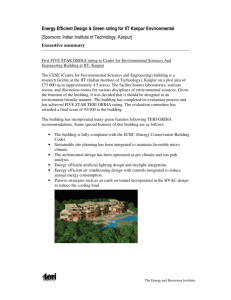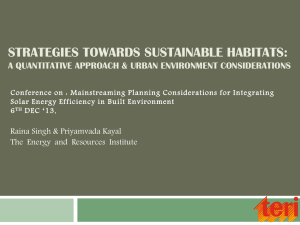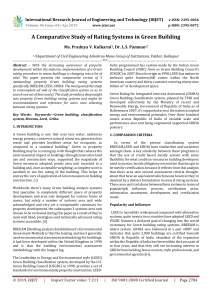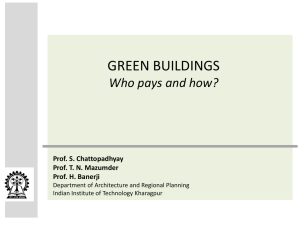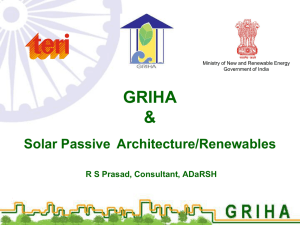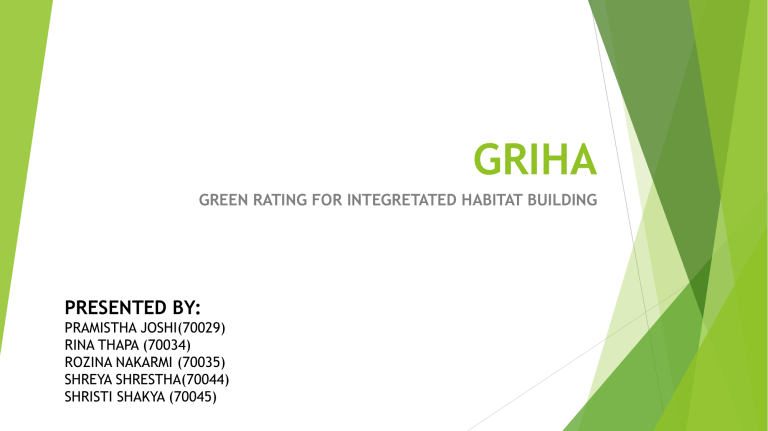
GRIHA GREEN RATING FOR INTEGRETATED HABITAT BUILDING PRESENTED BY: PRAMISTHA JOSHI(70029) RINA THAPA (70034) ROZINA NAKARMI (70035) SHREYA SHRESTHA(70044) SHRISTI SHAKYA (70045) CONTENTS 1. BACKGROUND 2. GOALS AND NEED OF GREEN BUILDING 3. BENEFITS OF GREEN BUILDING 4. INTRODUCTION OF GRIHA 5. EVOLUTION OF GRIHA 6. OBJECTIVES OF GRIHA 7. WHY CHOOSE GRIHA (COMPARE WITH LEED INDIA) 8. FIVE ‘R’ PHILOSOPHY 9. GRIHA PROCEDURE 10. GRIHA RATING SYSTEM 11. GRIHA OVERVIEW 12. GREEN BUILDING EXAMPLE USING GRIHA 13. COMPARATIVE ANALYSIS OF GRIHA WITH OTHER RATING SYSTEM 14. CONCLUSION BACKGROUND WHAT IS GREEN BUILDING? A ‘green’ building is a building that, in its design, construction or operation, reduces or eliminates negative impacts, and can create positive impacts, on our climate and natural environment. Green buildings preserve precious natural resources and improve our quality of life. GOAL OF GREEN BUILDING To help to sustain the environment without disrupting the natural habitats around it To promote a better planet earth, and a better place for us all to live Reduce trash, pollution and degradation of environment. Create a sound indoor environment for living and working purpose. FEATURES WHICH CAN MAKE A BUILDING ‘GREEN’ Efficient use of energy, water and other resources Use of renewable energy, such as solar energy Pollution and waste reduction measures, and the enabling of re-use and recycling Good indoor environmental air quality Use of materials that are non-toxic, ethical and sustainable Creating resilient and flexible structures Consideration of the environment in design, construction and operation Consideration of the quality of life of occupants in design, construction and operation A design that enables adaptation to a changing environment BENEFITS OF GREEN BUILDING ENVIRONMENTAL BENEFITS: Reduce wastage of water Conserve and restore natural resources Improve air and water quality Enhance protect biodiversity and ecosystems ECONOMIC BENEFITS: Reduce operating costs Improve occupant productivity Create market for green product and services SOCIAL BENEFITS: Improve quality of life Minimize strain on local infrastructure Improve occupant health and comfort GREEN BUILDING RATING SYSTEM WHAT IS GREEN BUILDING RATING SYSTEM? A rating system can be defined as a set of prerequisites and requirements that a project team must fulfill in order to receive certification. TYPES OF RATING SYSTEM BREEAM- United Kingdom BEAM- Hong Kong LEED- United States EEWH- Taiwan Green globes- Canada GBCS- South Korea Green star- Australia CASBEE- Japan GRIHA- India INTRODUCTION OF GRIHA WHAT IS GRIHA? Name: GRIHA is an acronym for Green Rating for Integrated Habitat Assessment. Country: INDIA Established : 2007 GRIHA is a Sanskrit word meaning – ‘Abode’. A innovative tool for sustainable development by the united nations A tool for implementing renewable energy in the building sector by ‘The Climate Reality project’- an organization founded by Mr. Al Gore; and UNEP-SBCI has developed the “Common Carbon Metric” (kWhr/sq m/annum), for international building energy data collection -based on inputs from GRIHA (among others) There are three primary Rating systems in India: GRIHA (Green Rating for Integrated Habitat Assessment) Green Rating for Integrated Habitat Assessment (GRIHA) is India’s own rating system jointly developed by TERI and the Ministry of New and Renewable Energy, Government of India. IGBC (Indian Green Building Council) LEED is developed by the U.S. Green Building Council (USGBC), the organization promoting sustainability through Green Buildings. BEE (Bureau of Energy Efficiency) It has star based rating system: more stars mean more energy efficiency. BEE has developed the Energy Performance Index (EPI). The unit of Kilo watt hours per square meter per year is considered for rating the building and especially targets air conditioned and non-air conditioned office buildings. EVOLUTION OF GRIHA OBJECTIVE OF GRIHA Minimize a building’s resource consumption, waste generation, and overall ecological impact Evaluates the environmental performance of a building holistically over its entire life cycle, thereby providing a definitive standard for what constitutes a ‘green building’ Based on accepted energy and environmental principles, seeks to strike a balance between the established practices and emerging concepts Reduced energy consumption without sacrificing the comfort level Reduced destruction of natural areas, habitats, and biodiversity, and reduced soil loss from erosion etc. WHY CHOOSE GRIHA? Two rating systems in India: LEED India and GRIHA LEED-India adapted from United States Green Building Council’s (USGBC) is primarily based on per capita energy consumption in developed nations like the US which does not work in India since India’s per capita energy consumption is very low compared to developed nations. GRIHA is more suited to Indian climate. Also unlike LEED, it does not promote usage of certain products like glass and air-conditioning equipment. FIVE ‘R’ PHILOSOPHY Refuse: To blindly adopt international technologies, products, etc. Especially in substitutes are available. trends, materials, areas where local Reduce: The dependence on high energy products, systems, processes, etc. Reuse: Materials, products, traditional technologies so as to reduce the costs incurred in designing buildings. Recycle: All possible wastes generated from the building site, during construction, operation and demolition. Reinvent: Engineering systems, designs and practices such that India creates global examples that the world can follow rather than India following the international examples. GRIHA PROCEDURE ELIGIBILITY Except for industrial complexes, all buildings (offices, institutions, hotels, hospitals, housing complexes, etc.) in the pre-design/design stage are eligible for certification under GRIHA. ADaRSH (Association for Development and Research of Sustainable Habitats), GRIHA secretariat helps evaluate whether the project is eligible for rating or not. GRIHA PROCEDURE REGISTRATION PROCESS Building project may register (http://www.grihaindia.org) The registration process allows access to essential information related to rating such as: 1. Application forms 2. List of submissions 3. Score points 4. The weightage system 5. Online documentation through the GRIHA website GRIHA PROCEDURE GRIHA also provides one day training session for the registered projects which includes: Overview of the green building design Explanation of the rating system and criteria and points related to rating Online access to the rating tool Documentation process through use of online forms Evaluation process GRIHA PROCEDURE EVALUATION PROCESS 1. Pre documentation stage: A team from ADaRSH along with the client’s Integrated Design Team meet and determine the points being targeted by the project. 2. Post documentation stage: All necessary proof through documents for the points targeted under various criteria is submitted. Evaluation by third party regional evaluators. To determine the final rating that shall be awarded to the project. GRIHA PROCEDURE After the necessary documentation is uploaded, and systems commissioned on the site, the buildings are evaluated and rated in three-tier process. The preliminary evaluation is done by a team of experts from ADaRSH. Reviewing of the mandatory points and checking for compliance. The project is rejected if mandatory criteria are not complied with. Evaluation of the optional criteria and estimation of the total number of achievable points. All compliance documents are examined through the appraisal process as outlined by GRIHA. Evaluation report given to members of an evaluation committee: external experts in building and landscape design, lighting and HVAC design, renewable energy, water and waste management, and building materials. The members independently review and award points, a provisional GRIHA rating is awarded after evaluation of document is submitted. GRIHA RATING SYSTEM VARIANTS OF GRIHA SVAGRIHA FOR BUILDING AREA- 100-2499 sqm GRIHA FOR BUILDING AREA-2500-1,50,000 sqm GRIHA LD FOR BUILDING AREA-> 50 hectare site area GRIHA VERISON 2015 The latest version of GRIHA, GRIHA version 2015 (GRIHA V2015), was introduced in January 2015. The GRIHA V 2015 rating system consists of 31 criteria categorized under various sections such as Site Planning, Construction Management, Occupant Comfort and Wellbeing, Sustainable Building Materials, Performance Monitoring and Validation, and Innovation Eligibility All buildings, which are in the design stage and have built up area more than 2,500 m2, are eligible for certification under GRIHA. GRIHA RATING CRITERIA Criteria and their weightage GRIHA is a performance-oriented system where points are earned for meeting the design and performance intent of the criteria. Each criterion has certain points assigned to it. It means that a project demonstrating compliance with a criterion would achieve the associated points. GRIHA is a 100-point system consisting of some core points Different levels of certification (one star to five stars) are awarded based on the number of points earned. The minimum points required for certification are 25. GRIHA RATING CRITERIA EVALUATED IN DIFFERENT STAGES Pre-construction stage (intra- and inter-site issues) Building planning and construction stages (issues of resource conservation and reduction in resource demand, resource utilization efficiency, resource recovery and reuse, and provisions for occupant health and well being). The prime 4 resources that are considered in this section are land, water, energy, air, and green cover. Building operation and maintenance stage (issues of operation and maintenance of building systems and processes, monitoring and recording of consumption, and occupant health and well being, and also issues that affect the global and local environment). GRIHA RATING CRITERIA GRIHA RATING CRITERIA GRIHA OVERVIEW The points assigned to different criteria is based on survey conducted to better reflect current resource priorities of India. The point split of various sections is given below: A Paradigm of self sufficiency - INDIRA PARYAVARAN BHAWAN This is a project of ministry of environment and forests for construction of new office building at New Delhi. The basic design concept of the project is to make the net zero energy green building. Location Plot = Jor Bagh,Delhi area = 9565 sq m Maximum Far ground coverage = 30% = 200 Height Built = 35 up area = 31400 sqm Superstructure Basement Year = 18726 sqm (8 storey ) = 12675 sqm (3 Basement) of completion = 2013 Project Leader = Mr.P.K.Gupta Architectural Design = Mr.R.K. Koshal Landscape Design = Mr.Sodhi Interior Design = Kothari Associates MEASURES FOR SITE Wider front setback (22m) to protect front tree line Preserve the integrity of the green street Preservation of the local ecology ,tree cutting approvals for 46,but only 19 cut,11 tress transplanted Excavated soil reutilized at other construction sites and the zoo ARCHITECTURAL CONCEPT Effective ventillation by Orientating The Building E-W Optimum integration with nature Separating Out Different Blocks with connecting corridors A huge Central courtyard Plan pedestrian axis to East ,North and West entrance without crisscrossing vehicles TOWARDS ENERGY POSITIVE APPROACH - RENEWABLE Façade has been designed to receive 70% of natural day light Inner courtyard serves as a light well. Provision of solar photovoltaics Photovoltaic stepping towards the south side Shades the roof Renewable Energy Façade of the building Solar PV System of 800 kW capacity Total Area : 6000 m Total Area of panels : 4650 m No of panels : 2,844 Annual Energy Generation : 14.3 lakh unit 2 2 Shadding from summer sun while allowing in winter sun ENERGY POSITIVE APPROACH Brown and beige coloured stone jaalis add to cross ventilation Central courtyard helps in air movement as natural ventilation happens due to stack effect. The terrace garden utilizes preserved top soil extracted during the initial excavation ENERGY POSITIVE APPROACH Preservation of existing foliage increasing the front set back. More than 50% area outside the building is soft with plantation and grassing. Circulation roads and pathways soft with grass paver blocks to enable ground water recharge Polymer plastics grids turn the visual asphalt fire tender road into a soft paved space SITE AND WASTE WATER MANAGEMENT To reduce landscape water requirements Drip irrigation Use of native species of shrubs and trees having low water demand in landscapping Low lawn areas so as to reduce water demand Reuse of treated water for irrigation Appropriate shading from summer sun ,while allowing in winter sun Reduce water use in building Dual flushing cistern Low discharge fixtures Waste water treatment Reuse of treated water for irrigation and cooling towers of HVAC Rain water harvesting –efficient water use during construction Drip irrigation MATERIALS AND CONSTRUCTION TECHNIQUES Ready Mix Concrete with PPC having more than 30% fly ash content Fly ash brick. Stone available in nearby area for Terrazzo flooring AAC (Aerated Autoclaved Cement ) blocks. Renewable bamboo jute composite material for door frames & shutters. UPVC windows with hermetically sealed double using low heat transmittance index glass. Use of high reflectance terrace tiles for low heat ingress. Avoided aluminum as it has high embedded energy Sandstone jaalis , stone and ferro-cement jaalis Grass paver blocks for ground water recharge Light shelves for bringing in diffused light ENERGY CONSUMPTION ON SITE - ZERO ENERGY Extra efficient Solar photo voltaic (SPV) proposed (Terrace and projections) =800 kW Energy produced in building/year = 14,91,000 Kwh Energy consumption for building/year = 14,21,000 kWH Geo thermal heat exchange system 180 vertical bores to the depth of 80 meter all along the building premises. Minimum 3 meter distance is maintained between any two bores. Each bore has HDPE pipe U-loop (32mm outer diameter) and grouted with Bentonite Slurry. Each U-Loop is connected to the condenser water pipe system in the central air conditioning plant room. One U-Loop has 0.9 TR heat rejection capacity. Combined together, 160 TR of heat rejection is obtained without using a cooling tower. Water pumping and treatment costs gets eliminated. Saves cooling tower fan energy. HVAC system - Chilled beam system 160 TR of air conditioning load of the building is met through Chilled beam system. Chilled beam are used from second to sixth floor. This reduces energy use by 40 % compared to a conventional system. HVAC load of the buildings is 40 m2/TR, about 50% more efficient than ECBC requirements (20 m2/TR) Chilled beams save AHU/FCU fan power consumption by approximate 50 kW. Fresh supply air is pre cooled from toilet exhaust air through sensible & latent heat energy recovery wheel. NET ZERO DESIGN IPB reduces energy requirements by 70% overall by conventional N-S orientation – Limiting WWR (Window to wall ratios ) Insulation on wall and roof Extensive greenery to reduce heat load Maximizing day lighting to reduce lighting loads Extremly low lighting power density -5 w/sqm Planning to minimize AC loads (keeping open atrium for cross ventilation, non conditioned lobbies) Efficient HVAC with screw chillers , VFD’S , Chilled beams Ground based heat exchanger for condenser water Energy efficient appliances (5 star BEE - Bureau of energy efficiency) S. N. DESCRIPTION CONVENTIO NAL IPB 1 Air – conditioning load 150 sqft /TR 450 sqft /TR 2 Lighting power density 1.1 W/ sqft (ECBC) 0.5 W/ sqft 3 Electrical load 10 W /sqft 4.3 W /sqft. CRITERIONS OF GRIHA FULFILLED – SITE PLANNING NO. CRITERION POINTS POINTS TARGETED 1 Site selection 1 2 Preserve and protect landscape during construction 5 5 3 Soil conservation (till post construction) 2 2 4 Design to include existing site features 4 4 5 Reduce hard paving on site and /or provide shaded hard –paved surfaces 2 2 6 Enhance outdoor lighting system efficiency and use renewable energy system for meeting outdoor lighting requirements 3 3 7 Plan utilities efficiency and optimize on site circulation efficiency 3 3 8 Provide at least ,minimum level of sanitation /safety facilities for construction workers 2 2 BUILDING PLANNING AND CONSTRUCTION STAGE SN CRITERION POINTS POINTS TARGETED 9 Reduce air pollution during construction 2 2 10 Reduce landscape water requirement 3 2 11 Reduce water use in the building 2 2 12 Efficient water use during construction 1 1 13 Optimize building design to reduce conventional energy demand 8 7 14 Optimize energy performance of building within specified comfort limits 16 16 15 Utilization of fly –ash in building in structure 6 4 16 Reduce volume ,weight and construction time by adopting efficient technologies (such as pre-cast systems) 4 2 RECYCLE,RECHARGE AND REUSE SN CRITERION POINTS POINTS TARGETED 17 Use low energy material in interiors 4 4 18 Renewable energy utilization 5 5 19 Renewable energy based hot water systems 3 3 20 Waste water treatment 2 2 21 Water cycle and reuse(including rain water) 5 3 WASTE MANAGEMENT 22 Reduction in waste water during construction 1 1 23 Efficient waste generation 1 1 24 Storage and disposal of wastes 1 1 25 Resources recovery from waste 2 2 HEALTH AND WELL BEING SN CRITERION POINTS POINTS TARGETED 26 Use low –VOC paints/adhesives/sealants 3 3 27 Minimize azone depleting substances 1 1 28 Ensure water quality 2 2 29 Acceptable outdoor and indoor noise levels 2 2 30 Tobacco smoke controls 1 1 31 Provide at least the minimum level of accessibility for persons with disabilities 1 1 32 Energy audit and validation Mandatory 33 Operation and maintenance 2 2 34 Innovation points 4 4 COMPARATIVE ANALYSIS WITH OTHER RATING SYSTEM CONTENTS GRIHA BREEAM LEED CASBEE MANAGING BODY TERI building research establishment (BRE) US green building Japan Sustainable Building Consortium(JSBC) ESTABLISHED 2007 1990 1998 2001 CATEGORIES/CREDITS •Sustainable site •Water management •Energy optimization •Waste management •Sustainable building materials •Health and well being •Building operation •Innovation •Health and well being •Transport •Materials •Waste management •Land use and ecology •Innovation •Location and transportation •Sustainable site •Energy and atmosphere •Indoor environment quality •Innovation •Regional priority •Built environment •Indoor environment •Quality of service •Outdoor environment on site •Built load •Energy resources and material •Off site environment CONTENTS GRIHA BREEAM LEED CASBEE BUILDING TYPE Commercial, residential, institutional, courts, educations, healthcare, prison Office retail, industrial units Health care facilities, schools, home, entire neighborhood Residential, and non residential type lf building GEOGRAPHICAL FOCUS Local, India and nearby area National National Global CERTIFIATION COST <5000 sq.m-INR 1,50,000 $1290 each stage 5,001 sq.m to 50,000 sq.mINR 1,50,000 + INR 3.5 per additional sq.m over & above 5,000 sq.m >50,001 sq.m-INR 3,10,000 $1250-$17500 $3570-$4500 •Award letter, certificate and plaque •Certificate and website published results RESULT REPRESENTATION RESULT PRODUCT •certificate certificate REFERENCE https://bharatvasandani.wordpress.com/2010/06/09/leed-vs-griha-puttingindian-developers-in-a-quandary/ http://www.grihaindia.org/#&home https://www.slideshare.net/sandeepnj7/certifcation-of-building-using-griharating-system-60638755?qid=58b7d73d-14b6-4540-b6941f7443e491d4&v=&b=&from_search=5 http://greencleanguide.com/national-mission-on-sustainable-habitat/ https://www.palmexindia.com/introduction-griha-apply-indias-best-knowngreen-rating-buildings/ http://www.indiaenvironmentportal.org.in/files/national-rating-systemgreen-buildings-GRIHA.pdf http://www.slideshare.net/supergirlanchal/indira-paryavaran-bhawan-andgriha-49343513
